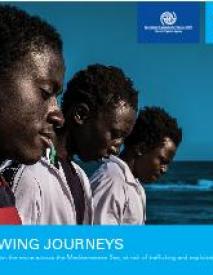Harrowing journeys : Children and youth on the move across the Mediterranean Sea, at risk of trafficking and exploitation
Young migrants and refugees set out to escape harm or secure better futures – and face staggering risks in the process. For 17-yearold Mohammad, who travelled through Libya to seek asylum in Italy, violence and persecution back home meant the choice was clear: “We risked our lives to come here,” he says, “we crossed a sea. We knew it is not safe, so we sacrificed. We do it, or we die.”
For children and youth on the move via the Mediterranean Sea routes to Europe, the journey is marked by high levels of abuse, trafficking and exploitation. Some are more vulnerable than others: those travelling alone, those with low levels of education and those undertaking longer journeys. Most vulnerable of all are those who, like Mohammad, come from sub-Saharan Africa.2 These findings come from a new UNICEF and International Organization for Migration (IOM) analysis of the journeys of some 11,000 migrant and refugee children (adolescents aged 14–17) and youth (18–24), as recorded in their responses to the Displacement Tracking Matrix Flow Monitoring Surveys conducted by IOM along the Central and Eastern Mediterranean routes to Europe in 2016 and 2017.
The analysis reveals that while adolescents and youth are at greater risk than adults on both routes, the Central Mediterranean route to Italy is singularly dangerous. It takes most young migrants and refugees through Libya, where they contend with pervasive lawlessness and violence and are often detained, by state authorities and others. On both routes, additional years of education and travelling in a group, whether with family or not, afford young migrants and refugees a measure of protection. But where they come from outweighs either of these factors. An adolescent boy from sub- Saharan Africa, who has secondary education and travels in a group along the Central Mediterranean route, faces a 75 per cent risk of being exploited.
If he came from another region, the risk would drop to 38 per cent. Anecdotal reports and qualitative research from the Mediterranean region and elsewhere suggest that racism underlies this difference. Countless testimonies from young migrants and refugees from sub-Saharan Africa make clear that they are treated more harshly and targeted for exploitation because of the colour of their skin. The story that emerges from the data confirms the tragic reality that adolescents and youth are prepared to pay a high price for a chance at a better life. Those interviewed in the surveys are among millions on the move worldwide, as recent decades have seen high levels of displacement, across borders and within countries. Many flee brutal conflicts or violence, while others move in search of prospects for better education or livelihoods.
With regular migration pathways barred for most, those seeking to make their way across borders often place their fates in the hands of smugglers. This alone leaves them dependent and vulnerable. They risk life and limb as they travel through harsh environments – and suffer appalling abuse and exploitation if they fall into the hands of traffickers, armed groups or other predators. As the world continues to grapple with the reality of migration and displacement, the findings from this report underscore the urgent need for action.
To protect the most vulnerable among those on the move, UNICEF and IOM call for a multi-pronged strategy that addresses the interplay of factors that expose migrant and refugee children and youth to risk – or help keep them safe. Such a strategy includes expanding safe and regular migration channels to dampen the demand for smugglers, while fighting trafficking and exploitation. To enhance the resilience and protect the rights of children and youth, it entails investing in education and other basic services, coordinating child protection efforts across countries, and fighting racism and xenophobia in the countries migrants and refugees travel through and the ones in which they seek to make their lives.
Geachte bezoeker,
De informatie die u nu opvraagt, kan door psychotraumanet niet aan u worden getoond. Dit kan verschillende redenen hebben,
waarvan (bescherming van het) auteursrecht de meeste voorkomende is. Wanneer het mogelijk is om u door te verwijzen naar de bron
van deze informatie, dan ziet u hier onder een link naar die plek.
Als er geen link staat, kunt u contact opnemen met de bibliotheek,
die u verder op weg kan helpen.
Met vriendelijke groet,
Het psychotraumanet-team.
63 pagina's | New York : UNICEF
https://www.unicef.nl/files/Rapport%20Harrowing%20jouneys%202017.pdf


